From Brandywine to Green Zebra: A Farmers Market Guide to Tomatoes
July 3, 2025
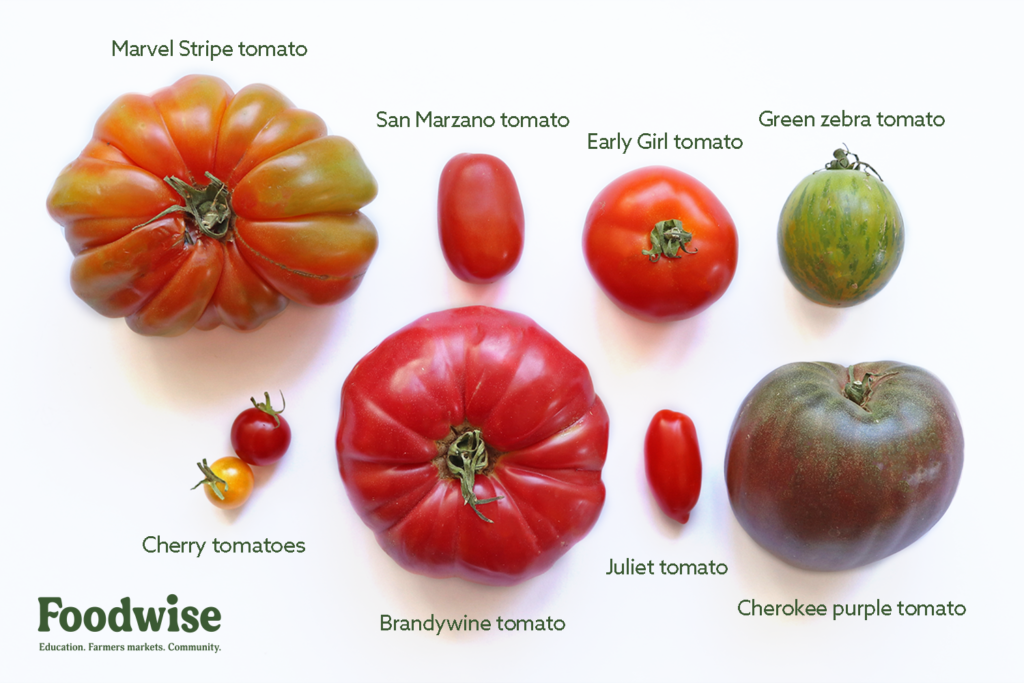
With tomato season in full swing, there’s a lot to love about the rainbow of variety you can find only at farmers markets. Solid, striped, or speckled and in red, yellow, green, purple, and every shade in between, tomatoes present an overwhelming choice, while the names of the varieties are as intriguing as they are colorful: Black Prince, Early Girl, Mortgage Lifter, Green Zebra, Ivory Pear, and Pineapple.
Amid all the variety, which tomatoes do you pick and what do you do with them? Here are some tips to help you navigate this juicy dilemma and make the most of peak tomato season. This month, stop by the orange Seasonal Spotlight tent at Foodwise farmers markets for recipes, cooking tips, and free samples to discover a variety of ways to use your tomatoes. Celebrate these delicious fruits with us at our Tomato Festival on July 26.
Find Tomatoes at These Farms at Foodwise Farmers Markets
Allstar Organics | Avila Farms | Balakian Farms | Blue House Farm | Dirty Girl Produce | Eatwell Farm | Everything Under the Sun | Gavel’s Farm | GG Farm | Green Thumb Farms | Heirloom Gardens | Knoll Farms | Lonely Mountain Farm | Lucero Organic Farms | Marin Roots Farm | Oya Organics | The Peach Farm | RHJ Farms | Yerena Farms
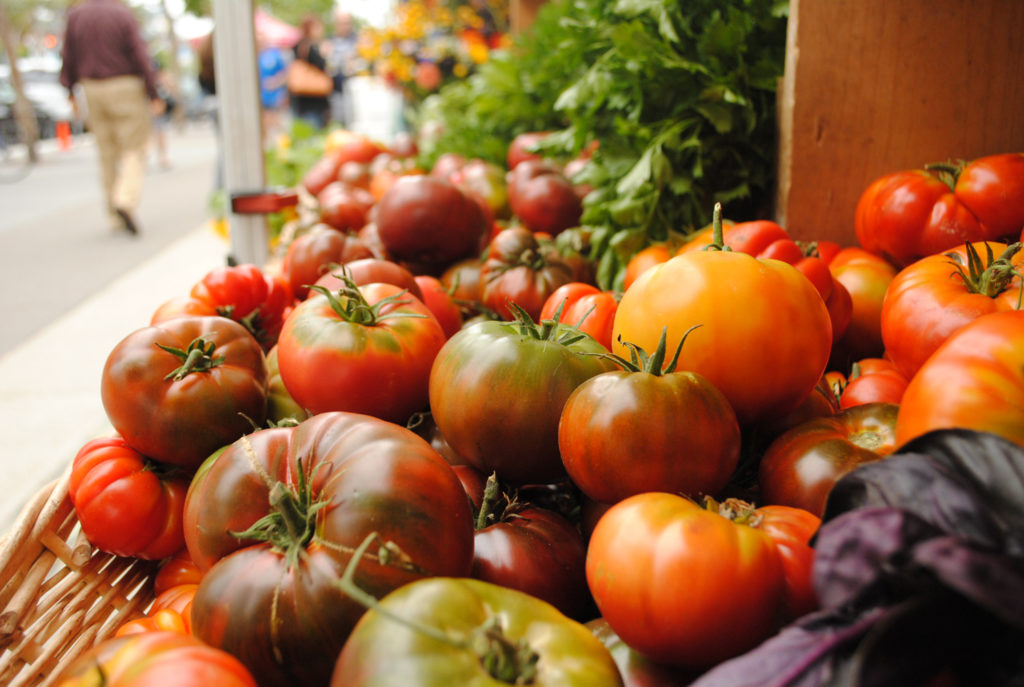
What Makes Farmers Market Tomatoes Special?
Some of the key differences between locally grown farmers market tomatoes and those you find at the grocery store are ripeness, flavor, and variety. Grocery store tomatoes are generally picked before they are fully ripe, so they can be transported long distances and stored for many days. Because they are picked, processed, and packaged before developing their full flavor, they often taste bland and mealy. Supermarket tomatoes are also missing a gene that allows them to produce sugar, which makes them lack that sweet, juicy flavor.
Farmers market tomatoes, on the other hand, are picked at peak ripeness and brought to the market when their flavor, juiciness, and nutrient value are at their full potential. That means they have a shorter shelf life, and you will need to handle them with care. While lackluster store-bought tomatoes are available year-round (generally because they are transported from other parts of the world), locally grown farmers market tomatoes are only available between June and October.
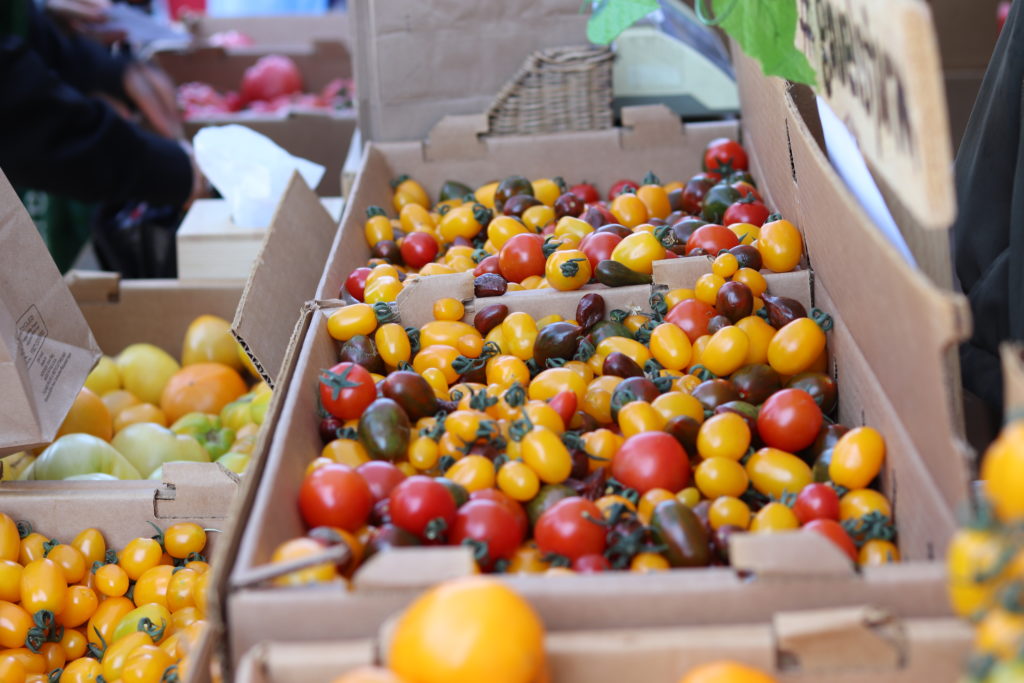
Tomato Seasonality: Hothouse vs. Field-Grown
Field-grown tomatoes are usually available at the farmers market June through October, though farms such as Peach Farm and Gavel’s Farm are able to extend the season by a couple of months by growing tomatoes in hothouses. Their vine-ripened tomatoes hit the farmers market in early spring, providing a sweet taste of the warm season ahead. During colder months, having greenhouses offers some control and predictability for farmers, but due to intensive labor and the use of energy, hothouse tomatoes make less sense in the summer months, especially when field-grown tomatoes are widely available.
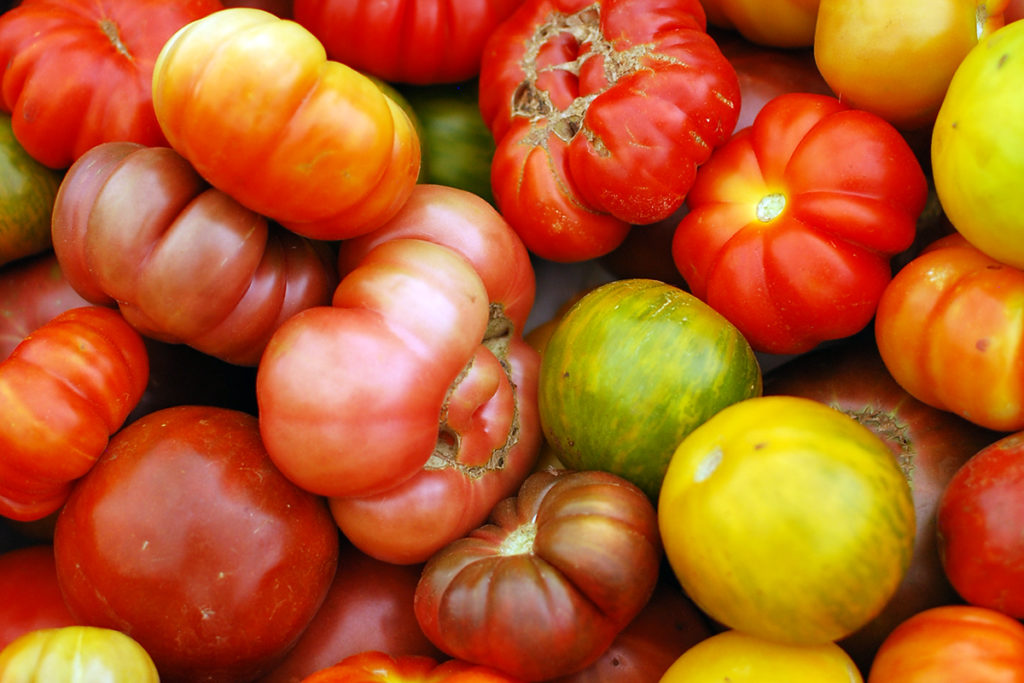
Heirloom vs. Hybrid
At the farmers market, you’ll also notice the diversity of heirloom tomato varieties, each one unique and tasty. Most people associate “heirloom” with big, juicy slicing tomatoes, but heirlooms come in all shapes and sizes. Heirlooms are varieties whose seeds have been saved by farmers and gardeners and passed down for generations, usually 50 years or more. Their seeds can be saved and replanted with fairly consistent results, and they tend to be genetically diverse, making them more adaptable to different growing conditions.
Hybrid seeds, on the other hand, are created by cross-pollinating two different varieties to yield offspring with desirable traits from both parent plants, such as disease resistance, uniformity, and high yield—a phenomenon known as “hybrid vigor.” Early Girl, Sun Gold, and Juliet are just a few of the popular hybrid tomatoes. While some argue that hybrids are more reliable and hardy than heirlooms, hybrids also have serious drawbacks because farmers must buy new seeds each year.
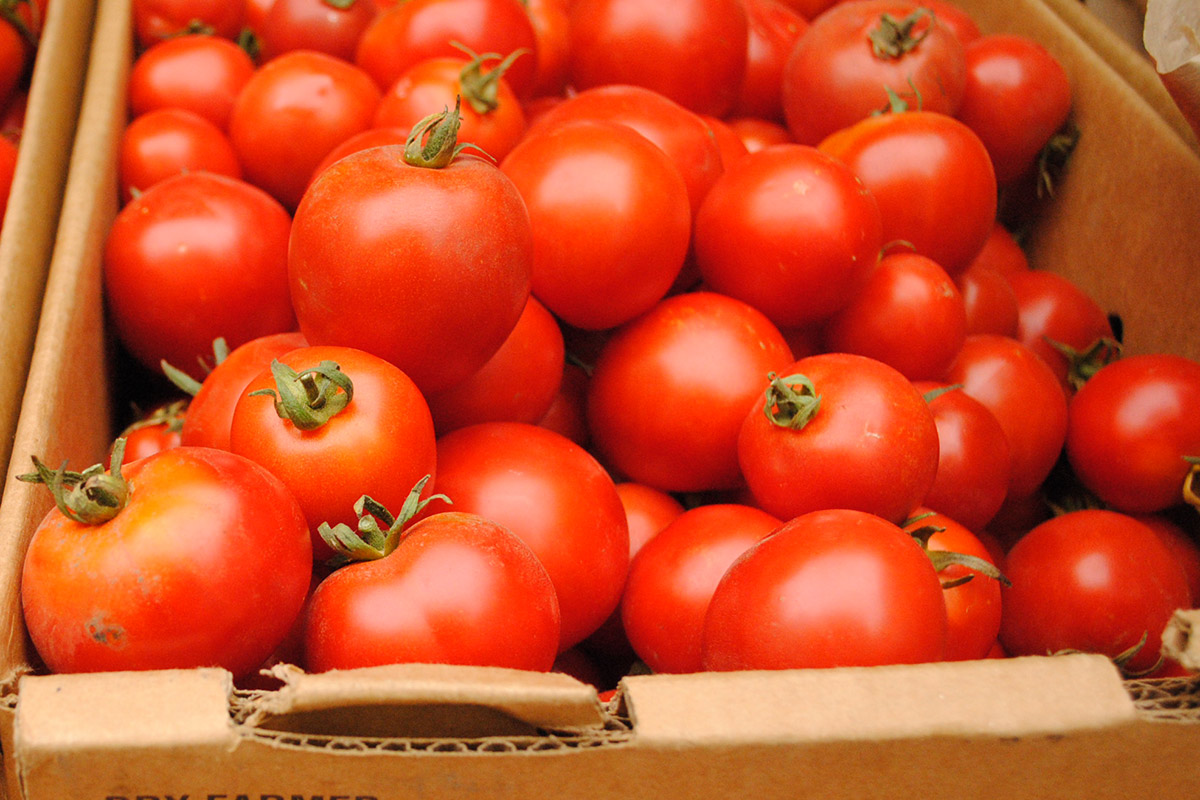
What about Dry Farming?
“Dry-farmed” tomatoes are sought after by home cooks and chefs alike, and usually start to appear at the farmers market in mid-summer. Some farms, such as Dirty Girl Produce, grow their tomatoes with this drought-friendly technique, which uses minimal irrigation while relying on soil moisture from seasonal rainfall or a single deep watering. Withholding irrigation once the tomato roots are established forces the plants to send their roots deeper into the soil and seek out water. This results in smaller but more flavorful tomatoes.

Common Types of Tomatoes
There are too many varieties of tomatoes to list here, but we’ve put together some of the more common ones you’ll find at the farmers market, along with some tips on how to enjoy them.
Beefsteak tomato
Beefsteak (or beef) tomatoes are as large as they are satisfying, with each fruit weighing between one and two pounds and growing up to six inches in diameter. Their firm, meaty texture makes them perfect for adding thick, hearty slices to burgers, sandwiches, and salads.
Recipe to try: Eggplant, Chickpea, and Tomato Bake (Musaqa’a) by Sami Tamimi and Tara Wigley, Falastin
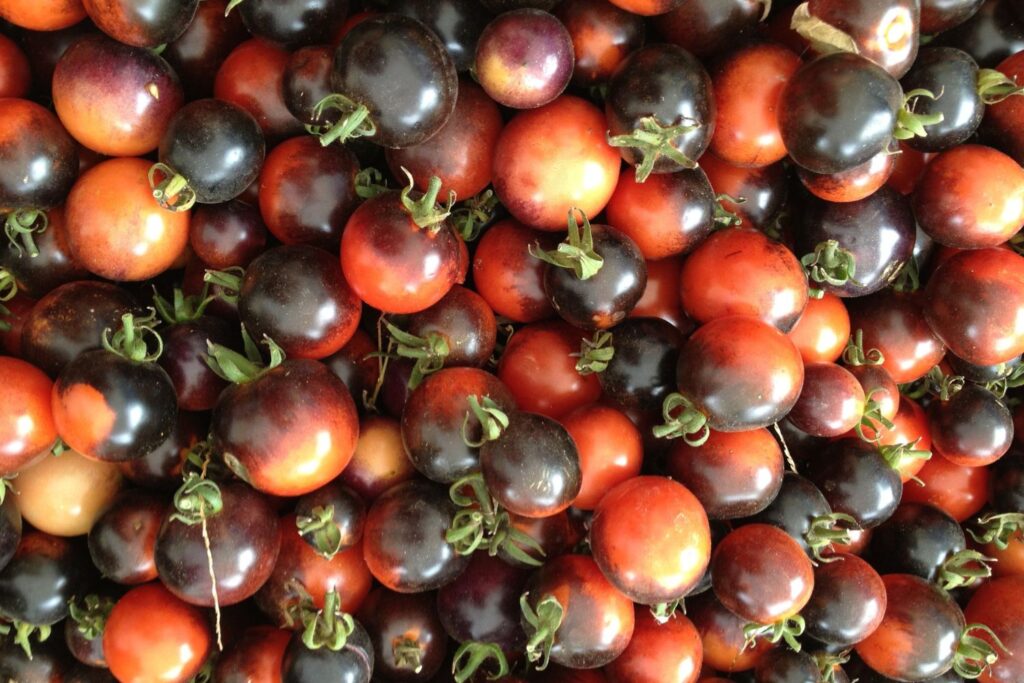
Black plum tomato
Black plum tomatoes are named for the deep wine tint on their skin. These small, oval-shaped fruits (yes, tomatoes are a fruit!) lend a sweet and tangy flavor, with a size perfect for snacking or blending into a sauce.
Recipe to try: Cabbage and Tomato Slaw by Chris Cosentino, Cockscomb and Boccalone
Brandywine tomato
Brandywine is a pink heirloom of the beefsteak variety—large, juicy varieties, perfect for slicing and eating raw. It has a robust tomato flavor and a deep pink-red color, but it also comes in other colors, such as yellow. You can slice them into salads or chop them into heirloom tomato sauces.
Recipe to try: Gnocchetti Sardi with Crushed Fresh Tomatoes, Basil, Pine Nuts and Ricotta Salata by Fernanda Baggio, Acquerello
Cherokee Purple tomato
The Cherokee purple tomato, another heirloom variety, was originally grown by Indigenous members of the Cherokee nation in Tennessee over 100 years ago. This fruit is known for its dark red-green-purple flesh and a deep red interior. Its sweet, rich taste is perfect to prepare in sandwiches or salads.
Recipe to try: Rainbow Tomato Salad by Anna Buss, Frog Hollow Farm
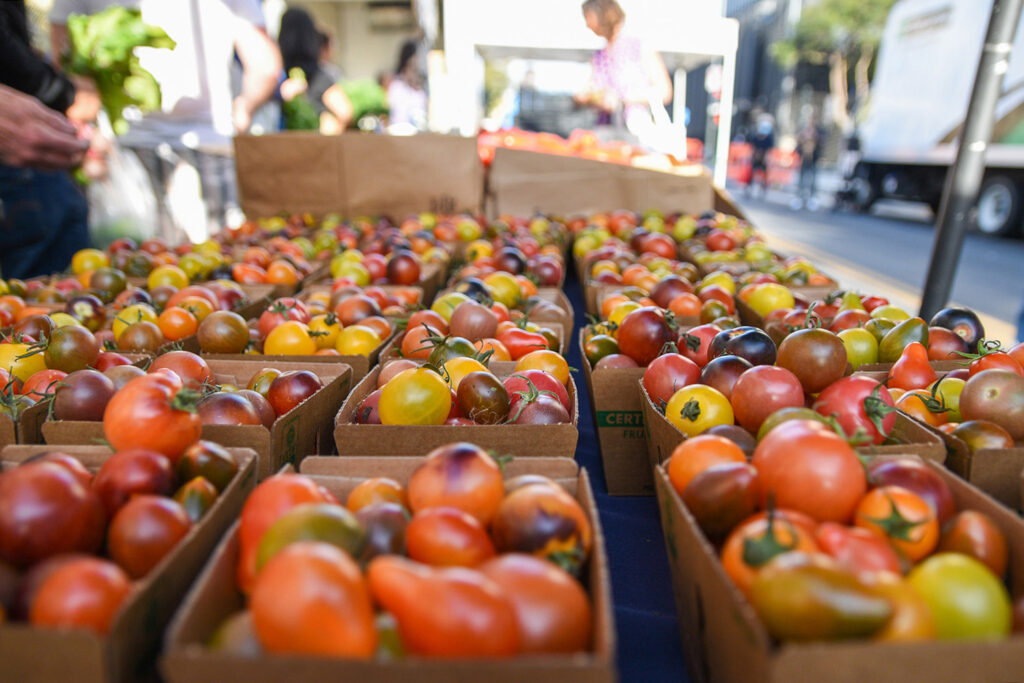
Cherry tomatoes
Cherry tomatoes range in size as well as colors, such as red, yellow, green, and even black! They come in many varieties, such as the popular Chelsea, Sweet 100, or the bright orange Sungold. Similar to grape tomatoes (which are also bite-sized but more oblong in shape), cherry tomatoes are extremely versatile and can be eaten raw as a snack, added as a garnish to salads, grilled on skewers, made into gazpacho, or roasted on a summer bruschetta or pasta.
Recipe to try: Cherry Tomato, Chive, and Gruyère Scones by Jen Musty, Batter Bakery
Early Girl tomato
Early Girl tomatoes tend to have thick skin, a compact, round shape, and deeply concentrated flavor, particularly when they are dry farmed. These rich, sweet tomatoes are great to incorporate into sauces, salads, gazpachos, and even jams.
Recipe to try: Roasted Early Girl Tomato Soup by David Little, Little Organic Farm
Green Zebra tomato
The Green Zebra has dark green and yellow stripes and is often more tart than normal tomatoes. Try them in gazpacho or caprese salads, or even fried. Keep an eye out for flame-striped Red Zebra tomatoes, too!
Recipe to try: Bruschetta with Stracciatella, Pesto, and Tomatoes by Audrey Hitchcock, Ramini Mozzarella
Juliet tomato
Resembling a small Roma, this plum tomato variety is slightly larger than a grape tomato and contains a sweet, fruity flavor. As they grow, these tomatoes rarely form cracks in the skin. It works well in salads and sauces.
Recipe to try: Ezme (Turkish Roasted Tomato Relish) by Joyce Goldstein
Marvel Stripe tomato
Considered the largest of bi-colored heirloom tomatoes, the Marvel Stripe tomato has a deep orange exterior and streaked thin, red strips. It has a smooth, bright, and sweet flavor, which can be prepared in salads or pastries for a sweeter fare.
Recipe to try: Tomato and Peach Salad with Okra, Radishes, and Benne Seed Dressing by Marcus Samuelsson, The Rise
Roma tomato
Roma tomatoes are more firm, have fewer seeds, and are less juicy, which makes them good for a variety of uses, whether canned, sundried, or made into a salsa. Their versatility and their meaty texture make them a popular choice for both home chefs and professionals alike as an ingredient in pastes, sauces, and other tomato-flavored bases to all of your favorite recipes.
Recipe to try: Salsa Tatemada by Rick Martínez, Mi Cocina
San Marzano tomato
A plum tomato variety, the San Marzano has a strong yet sweet taste and tends to be less acidic. Most people use these paste tomatoes for canning, but you can incorporate them into a tomato sauce as well.
Recipe to try: Stuffed Peppers with Fresh Tomato Sauce by Alison Mountford, Square Meals
Speckled Roman tomato
True to its name, this speckled tomato is covered in light orange, vertical stripes. The cherry-sized tomato was created as a cross between yellow Banana Legs and Antique Roman tomatoes. Their tangy flavor blends well with sauces of all kinds.
Recipe to try: Roasted Tomato Pasta Sauce by Bill Crepps, Everything Under the Sun
This article was updated from a previously published version.
Topics: Farmers market, Produce guides, Vegetables
